25 Types of Mushrooms For Food and Medicine
Contents
- 1. Agaricus bisporus
- 2. Agaricus subrufescens
- 3. Agrocybe aegerita
- 4. Auricularia auricula
- 5. Calocybe indica
- 6. Coprinus comatus
- 7. Cordyceps militaris
- 8. Flamulina velutipes
- 9. Ganoderma lucidum
- 10. Grifola frondosa
- 11. Hericium erinaceus
- 12. Hypsizygus tessellatus
- 13. Lentinula edodes
- 14. Morchella esculenta
- 15. Pholiota adiposa
- 16. Pholiota nameko
- 17. Pleurotus djamour
- 18. Pleurotus eryngii
- 19. Pleurotus nebrodensis
- 20. Pleurotus ostreatus
- 21. Pleurotus cintrinopileatus
- 22. Stropharia rugosoannulata
- 23. Trametes versicolor
- 24. Tremella fuciformis
- 25. Volvariella volvacea
You might not notice it on a daily basis, but we humans are growing a lot of mushrooms.
In fact, worldwide production of all types of mushrooms is in excess of 30 million tons annually.
Holy Shiitake!
Of course, the familiar button mushrooms and oyster mushrooms take up a large percentage of this total, but there are dozens of other interesting mushroom types cultivated and enjoyed on a large scale that you really should know about!
1. Agaricus bisporus
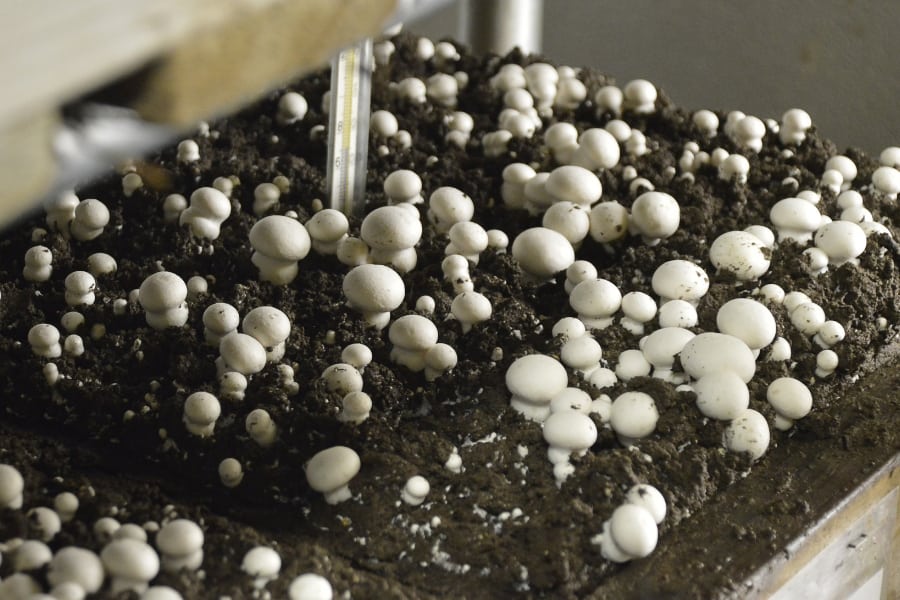
Common Name: White Button, Portabello
Type: Gourmet
I want you to close your eyes and picture a mushroom…
There’s a good chance that it’s the White Button Mushroom that pops into your head first. Buttons are by far the most commonly cultivated mushroom in North America.
In fact, about 900 million pounds are produced each year in the United States alone!
People started growing button mushrooms- or Champignons– in France, over 300 years ago. They were originally “cultivated” by simply digging up the mycelium of wild fruits and planting them in underground caves.
Today, agaricus farms are typically left up to the big guys- gigantic commercial operations that are made profitable due to the sheer volume of mushrooms produced. Since this mushroom is so common, it fetches a low price per pound at the market, making it very difficult for small farmers to get in on the action.
Button mushrooms are delicious and versatile, and can be added to almost any meal. People are also using this mushroom as a meat substitute. The portabello can be crushed up and formed into a vegan-friendly burger patty.
Fun Fact: Most people think that White Buttons and Portabellos (portabellas) are different mushrooms, but they are actually the exact same species. The “White Button” was a natural mutation discovered in 1926, which was subsequently cultured and used for cultivation. Large portabellos are simply brown button mushrooms which are allowed to grow to maturity.
2. Agaricus subrufescens
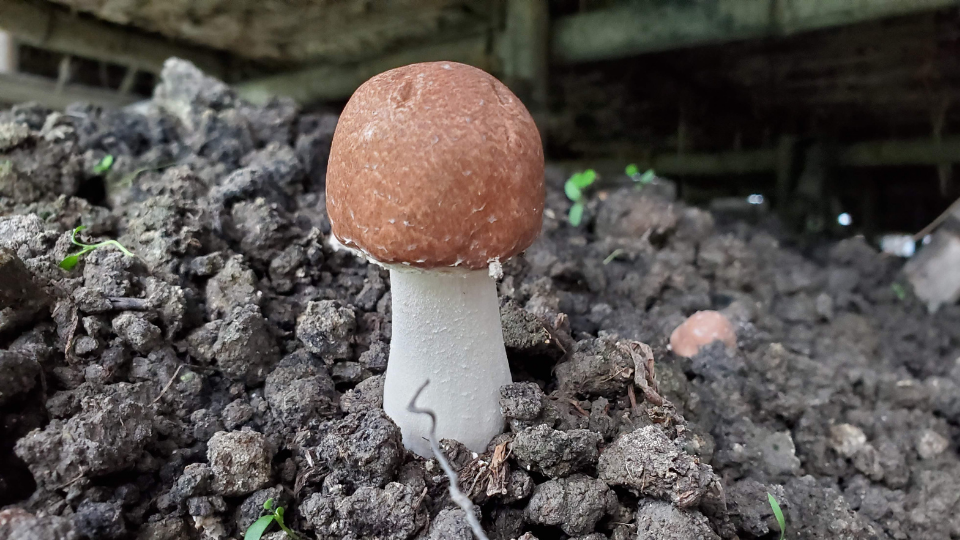
Common Name: Agaricus Blazei, Almond Mushroom, Royal Sun Agaricus
Type: Gourmet, Medicinal
The almond mushroom is a gourmet and medicinal mushroom commonly grown in places with warmer climates like Brazil, China, and Japan.
It’s sold fresh as a gourmet mushroom, and is also extracted and powdered to be sold as a natural health product.
Agaricus Blazei has been studied for anti-tumor properties and its ability to support the immune system. It is also thought to be a powerful anti-inflammatory.
Fun Fact: Like other Agaricus species, this mushroom contains ergosterol, a compound that is converted to vitamin-D when exposed to light. Interestingly, this makes mushrooms one of the only non-animal sources of this essential vitamin!
3. Agrocybe aegerita

Common Names: Piopinno, Piopinni, Black Poplar
Type: Gourmet
This mushroom grows primarily on hardwood and fruits prolifically in beautiful clusters. It is relatively easy to cultivate, and seems to be gaining popularity among small scale growers.
Black poplar is very commonly cultivated in Japan and Korea using bottle farming technology. Although it does grow wild, foraging for this mushroom would not be recommended, since it can be hard to identify from other poisonous species.
This mushroom is a wonderful addition to many meals, and imparts a satisfying nutty flavor.
4. Auricularia auricula

Common Name: Wood Ear, Jelly ear
Type: Gourmet, Medicinal
This mushroom is popular in China, where it is added to soups and other dishes. It has a rubbery texture- so rubbery, in fact, that it’s not really considered an edible species by many in North America.
The Jelly Ear has a number of potential medicinal applications. Traditionally, it was boiled in milk or alcohol to treat sore throats. More recent research has shown potential applications for lowering cholesterol and suppressing tumor growth.
The Jelly Ear is a common mushroom found fruiting naturally in forests all over the world. When cultivated, it is usually done outdoors on logs. Research has shown potential for this mushroom to be a “secondary forest product”.
5. Calocybe indica
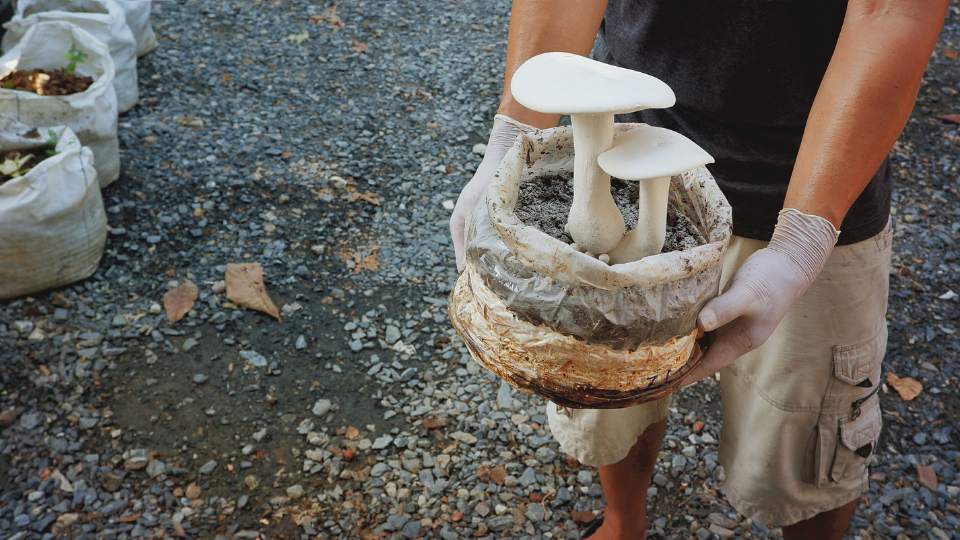
Common Name: Milky mushroom
Type: Gourmet
The milky mushroom can grow huge, and is is one of the coolest looking mushrooms around.
These mushrooms are native to India, where wild harvested specimens were sold at local markets.
Milky mushroom prefers warmer climates, and can grow in places with temperatures regularly exceeding 30 degrees Celsius- making them a perfect candidate for cultivation in Southern India and other warm and humid climates.
The fruiting bodies are large, and have thick, solid stems and meaty texture. They can be added to many different meals. They have a long shelf life, and do not bruise brown like many other similar species.
Milky mushrooms are also high in ergothioneine, a powerful antioxidant.
Fun Fact: The Milky Mushroom wasn’t cultivated commercially until 1998! It wasn’t even known as an edible species until 1972.
Now, Milky Mushrooms are produced in India at a rate of over 40, 000 tons per year.
6. Coprinus comatus
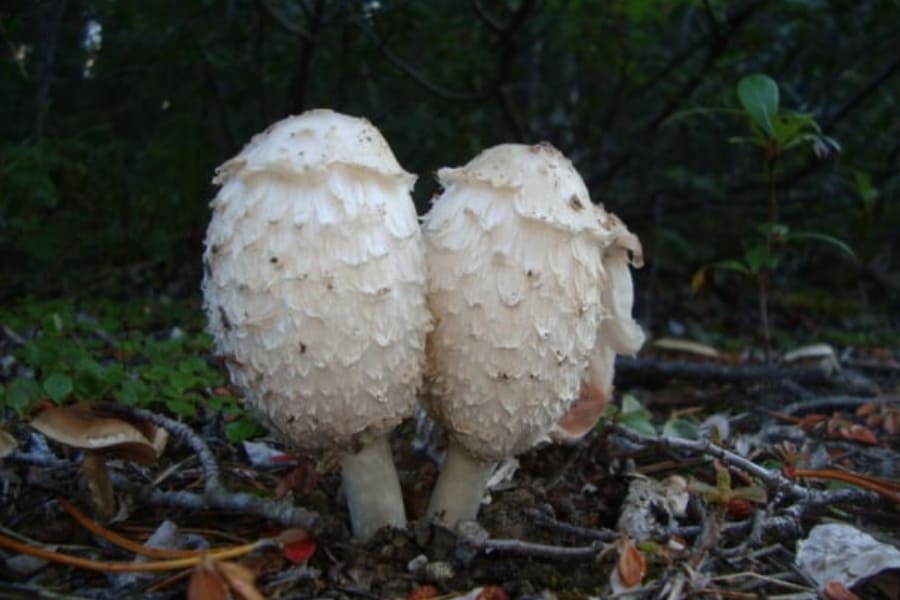
Common Names: Shaggy Mane, Shaggy Ink Cap
Type: Gourmet
It’s definitely possible to cultivate Shaggy mane, but very few growers do.
That’s because in as little one day after harvest, the Shaggy Mane will “deliquesce” into pile of black goop. Kind of hard to sell that at the grocery store!
When fresh however, Shaggy Ink Caps are a gourmet edible, and best added to soups and stews.
Shaggy Mane can be cultivated on manure based substrates, in bags or trays. It can also be grown outdoors in straw beds.
Foragers often find wild Shaggy Mane fruiting on well-fertilized lawns and public parks. It has a distinctive “shaggy appearance” and is relatively easy to identify- although when young it can be confused with other poisonous species.
Fun fact: Shaggy Mane contains “Coprine” a compound that, when mixed with alcohol, can cause nausea, vomiting, heart palpitations, and other nasty side effects. These “poisonings” are usually short lived and not often serious. Either way, it’s best to avoid having a glass of wine with this gourmet edible!
7. Cordyceps militaris
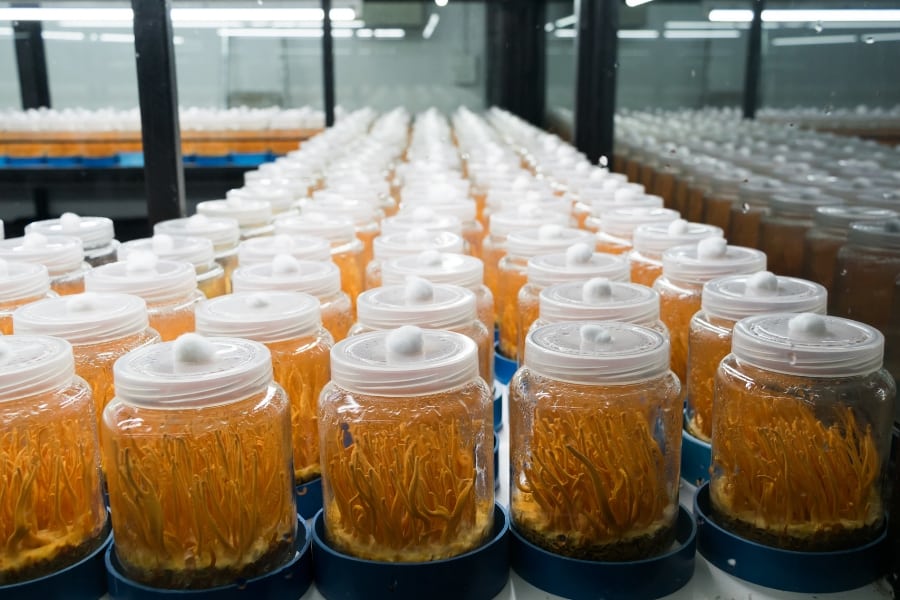
Common Name: Cordyceps
Type: Medicinal
Most people confuse Cordyceps militaris with its close cousin, the “winter worm” or Cordyceps sinensis.
C. sinensis, however, is a weird one.
It naturally grows from the zombified brains of caterpillars high in the mountains of Tibet. So far, it has evaded any attempts at commercial cultivation.
C. militaris, on the other hand, can be successfully fruited on rice-based substrates under laboratory controlled conditions. It is currently cultivated on a mass scale in China, and some commercial cultivation projects are taking place in the USA.
Cordyceps militaris is used as a powerful supplement, and has the same beneficial compounds as worm-grown Cordyceps… but with no insects required!
It is known to boost energy, endurance, and stamina, and is typically used by athletes.
8. Flamulina velutipes
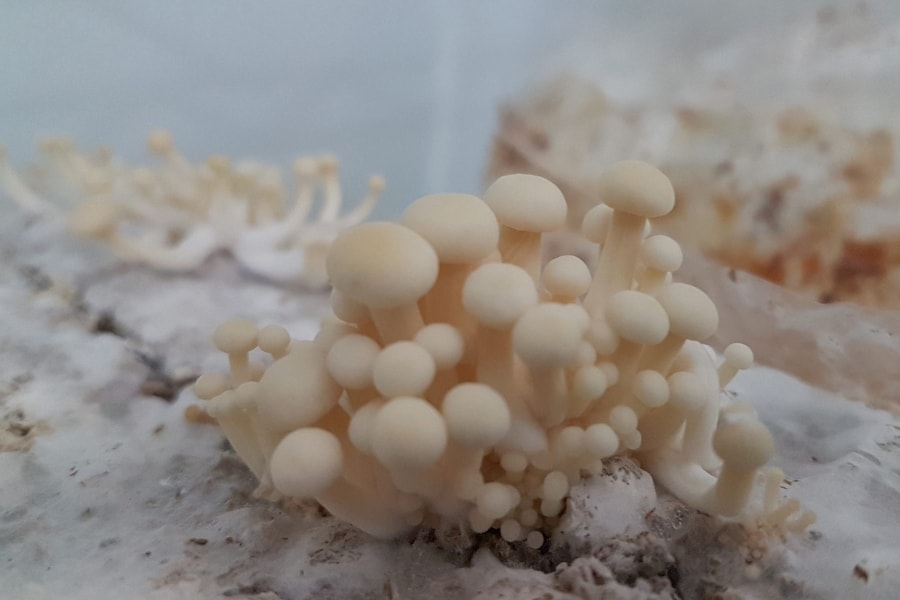
Common Names: Enoki, Enokitake, Winter Mushroom
Type: Gourmet, Medicinal
Believe it or not, Enoki is one of the most commonly grown mushrooms in the world. It is most often grown with intentionally elongated stems and tiny caps. This mushroom is used in Asian cooking, but also has medicinal properties.
The Japanese have been growing Enoki for over 300 years! It was originally grown outdoors on logs, but cultivation methods have since evolved to use the highly productive “bottle-culture” techniques.
Light and CO2 levels can have a huge impact on the appearance of Enoki fruit bodies.
When found in the wild it has a large cap and brown-red features. When grown in a bottle culture, it forms tight clusters of tiny thin-stemmed mushrooms with minuscule white caps. The two are almost unrecognizable!
9. Ganoderma lucidum
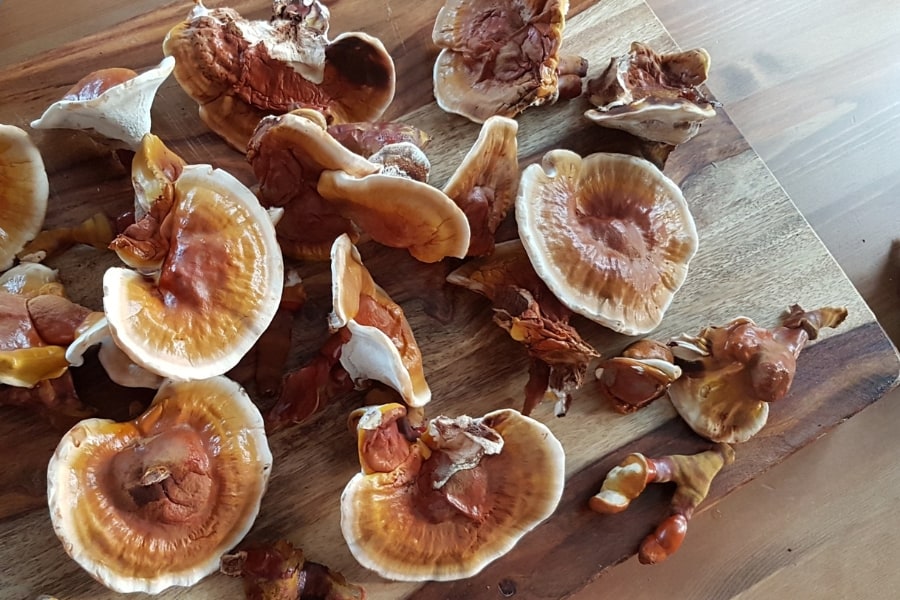
Common Names: Reishi, Varnished conk
Type: Medicinal
Reishi is arguably one of the most beautiful mushrooms in the world.
It starts in “antler” form, with tiny finger like projections that eventually spread out and transform into large, shiny-red “conks.”
This mushroom is definitely not a good choice for the kitchen. It is as tough as the wood it grows on, and insanely bitter.
However, Reishi has powerful medicinal properties which make it a prime candidate for cultivation all over the world.
Traditionally, this mushroom is prepared by making a tea, using hot water to extract the beneficial compounds.
Reishi is typically grown on hardwood sawdust indoors, or on buried hardwood stumps outdoors. It’s a slow growing warm weather species, and requires much less humidity than most other species.
10. Grifola frondosa
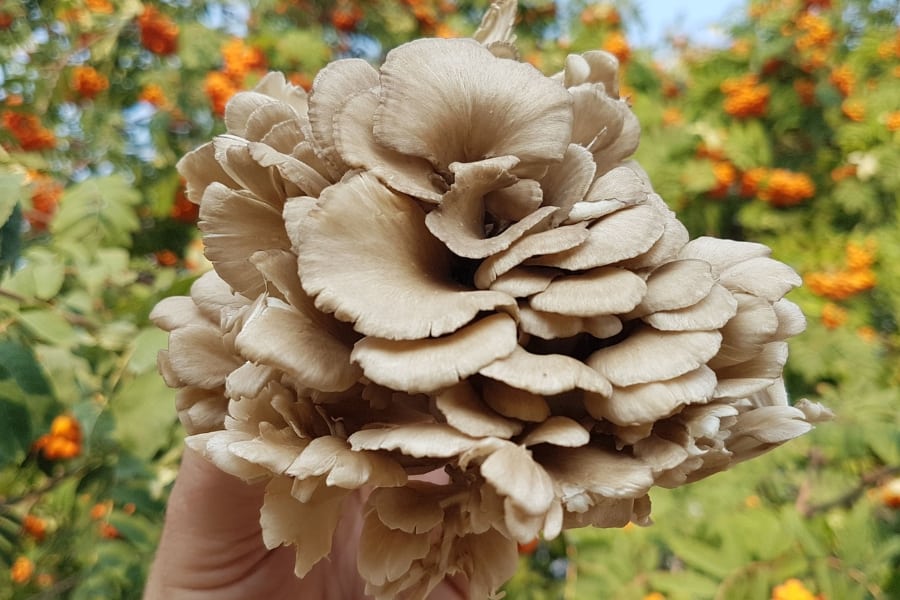
Common Names: Maitake, Sheep’s Head, Ram’s Head
Type: Gourmet, Medicinal
If you are ever lucky enough to find Maitake in the woods, feel free to do your happy dance. That’s what ancient Japanese did when they stumbled upon it, and is also why it is known as the “dancing mushroom” in Japan.
Luckily, this delicious mushroom is widely cultivated- mostly in Asian countries, although it is becoming much more common in North America. Maitake can be grown in bottles and bags, developing tiny wrinkles which eventually develop into large folding bouquets.
The size of Maitake fruit bodies is highly correlated to the volume of substrate it grows on. When grown in bottles, it forms small fist-sized clusters, whereas when grown in larger bags, the fruits are significantly larger. Wild specimens have been found at over 100 lbs!
Maitake is one of the most interesting medicinal species, being studied for its ability to improve blood sugar levels in diabetes patients, among other medicinal applications.
Fun Fact: Maitake has the rare distinction of a “soft-polypore”. Most polypores (meaning having pores in place of gills) have a solid woody texture, making them unfit for culinary applications. Maitake, on the other hand, is an excellent gourmet species!
11. Hericium erinaceus
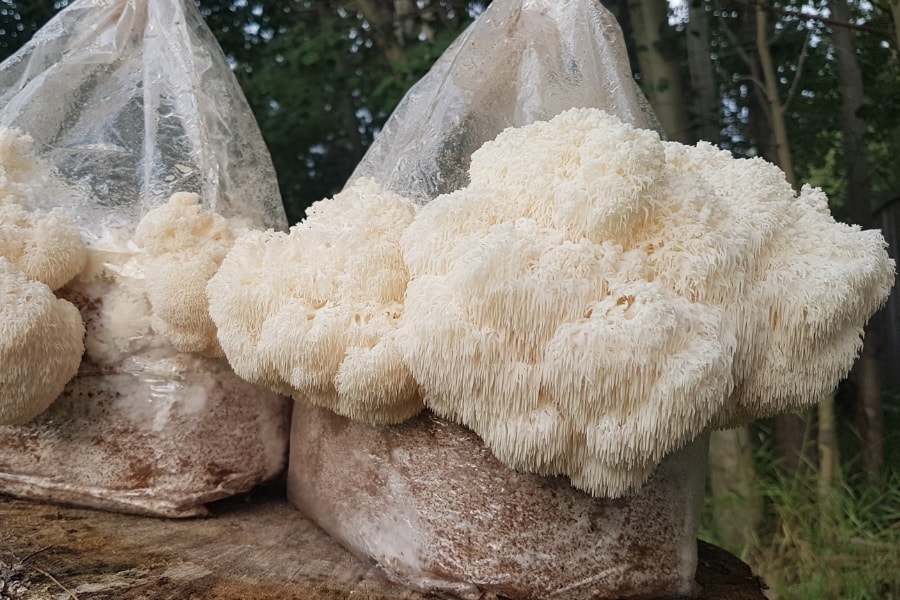
Common Names: Lion’s Mane, Pom-Pom, Yamabushiitake
Type: Gourmet, Medicinal
Lion’s Mane tastes unbelievable good, is easy to grow, and does amazing things for your brain.
It’s also one favorite mushrooms of all time!
Lion’s mane is not your typical cap-n-stem mushroom- preferring to grow in snowball like formations. Instead of gills, it uses elongated “teeth” for spore dispersal.
It is commonly cultivated in mushroom grow bags on hardwood sawdust. The fruit bodies are quite fragile, and great care must be taken during harvest to reduce bruising and extend shelf life.
This mushroom makes a good replacement for meat, and can be used in place of chicken or seafood in many recipes. I even like to just fry it up with butter!
Lion’s Mane is also a potent nootropic, able to help boost cognitive function and memory. Research is being done on how Lion’s Mane might be able to help sufferers of dementia and Alzheimer’s.
12. Hypsizygus tessellatus
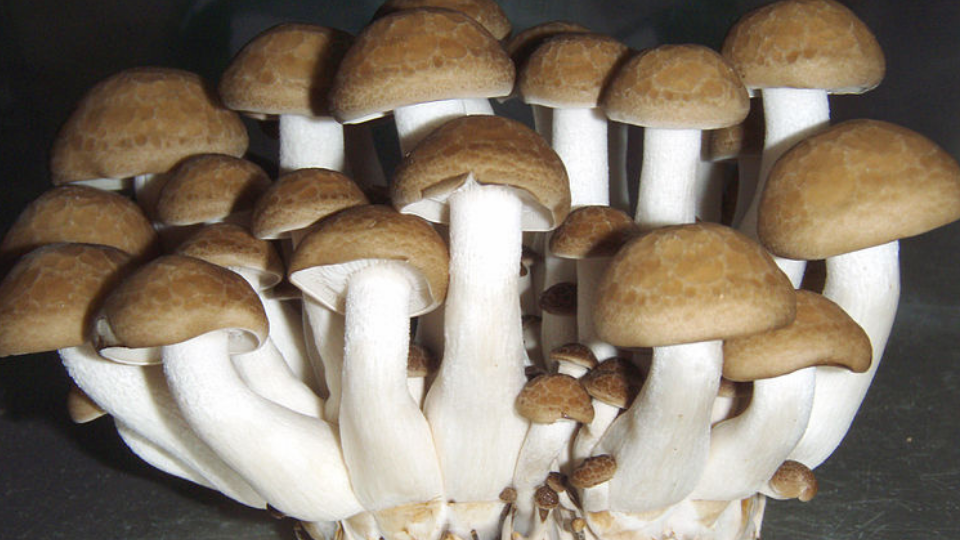
Common names: Shimeji, Beech Mushrooms
Type: Gourmet
This mushroom, or a version of it, is common to find at the grocery store. They have excellent shelf life, and can easily be shipped overseas.
Shimeji are an perfect candidate for bottle farming, which is the typical method of cultivation for this species in Japan.
Like button mushrooms, Shimeji comes in both white and brown varieties, and are common in Asian cuisine.
They have a bitter taste that disappears with cooking, and is replaced with a pleasant nutty flavour. A good addition to stir-frys.
13. Lentinula edodes

Common Name: Shiitake
Type: Gourmet, Medicinal
Shiitake is one of the oldest cultivated mushrooms, and is still widely cultivated all over the world today- responsible for a quarter of annual production worldwide.
Traditionally, Shiitake was cultivated outdoors on logs, using the “soak and strike” method. Most commercial Shiitake operations today use the more efficient bag method of cultivating on hardwood sawdust.
Shiitake can be fickle… it won’t grow on many different substrates, and won’t take to bottle farming techniques.
Either way, people are growing- and eating- a lot of Shiitake!
And for good reason.
Shiitake can be used fresh or dried, has an excellent shelf life, and can be added to all sorts of meals. It also has many beneficial medicinal properties, and is reported to have amazing benefits for the skin.
14. Morchella esculenta

Common Name: Morel
Type: Gourmet
The morel is an unbelievably tasty mushroom, attracting foragers from far and wide wherever it decides to fruit. Chefs and foodies alike will happily shell out big bucks to get their hands on a basket of fresh morels. In fact, there’s an entire economy built up around the market for wild-harvested morels.
Because they fetch such high prices, people have been trying to cultivate Morels for decades- but with almost zero commercial success.
They were just thought to be too hard to grow!
Recently though, there have been breakthroughs in the cultivation of this once elusive species.
Check out this video below of a Morel farm in China.
Feeling inspired yet?
There are currently projects underway to grow morels on a commercial scale in the US, mainly using indoor cultivation techniques. More breakthroughs in morel cultivation techniques would certainly have a massive impact on the wild mushroom market.
Fun fact: Morel’s are a chef’s delight, but you should never eat them raw. They need to be cooked in order to destroy poisonous compounds that can cause stomach upsets, vomiting and diarrhea.
15. Pholiota adiposa
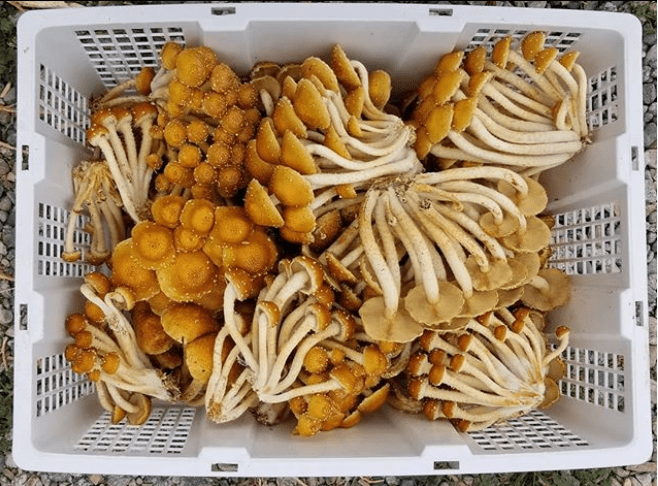
Photo from What The Fungus, wtfmushrooms.ca, @what_the_fungus on Instagram.
Common Name: Chestnut
Type: Gourmet
This is one of the coolest looking mushrooms! It has a rough cap, and grows in beautiful symmetric clusters.
The Chestnut mushroom is naturally found in Europe.
Although not very common as of yet, commercial cultivation is underway and growing in popularity.
This mushroom is high in polysaccharides, and is being studied for its anti-tumor and antimicrobial effects.
16. Pholiota nameko
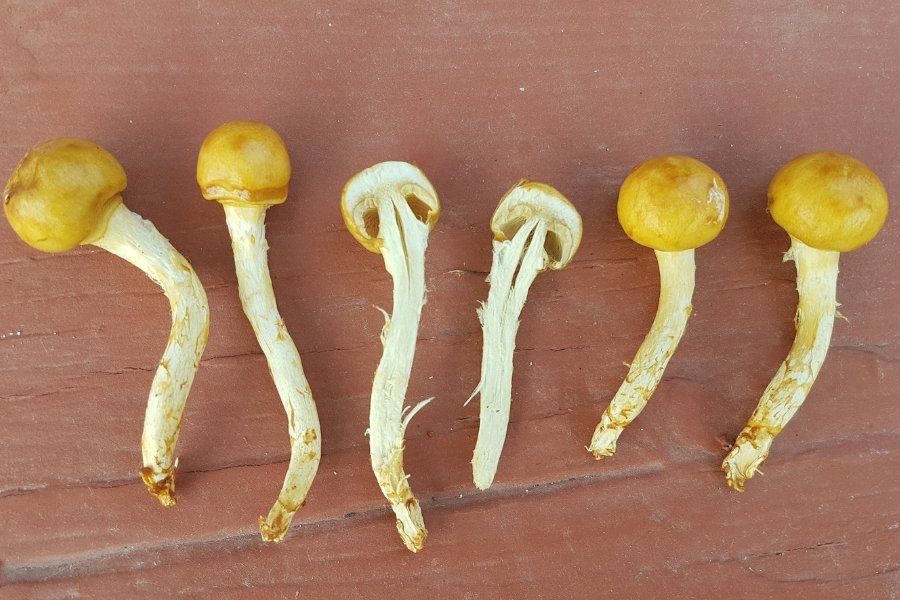
Common Names: Nameko
Type: Gourmet
Nameko grows small clusters of little brown-orange mushrooms with naturally “viscid” caps.
Many people who see these in the grocery store might think that the mushrooms have gone bad- but the slimy caps are completely natural.
They make a great addition to soups, as the gelatinous coating on the caps can serve as a thickening agent. It is a standard ingredient in miso soup. It is also commonly used in stir fry’s, and has a nice nutty flavor.
Nameko grows on wood, and is commonly grown using bottle farming techniques.
17. Pleurotus djamour

Common Names: Pink Oyster, Salmon Oyster
Type: Gourmet
The Pink Oyster is certainly a head turner.
The entire mushroom is vibrantly pink, and looks amazing on a table at the farmers market. They can be used in cooking like all other oyster mushrooms, although they do lose most of their color when heat is applied.
Cultivated Pink Oysters have a really short shelf life, which is why you are unlikely to see them at the grocery store. A few days after harvest, they start to get a foul smell, and soon turn inedible.
Pink Oysters are can be grown on straw or hardwood, and do better in warmer climates. The mushroom can withstand high temperatures throughout the entire growing process.
18. Pleurotus eryngii
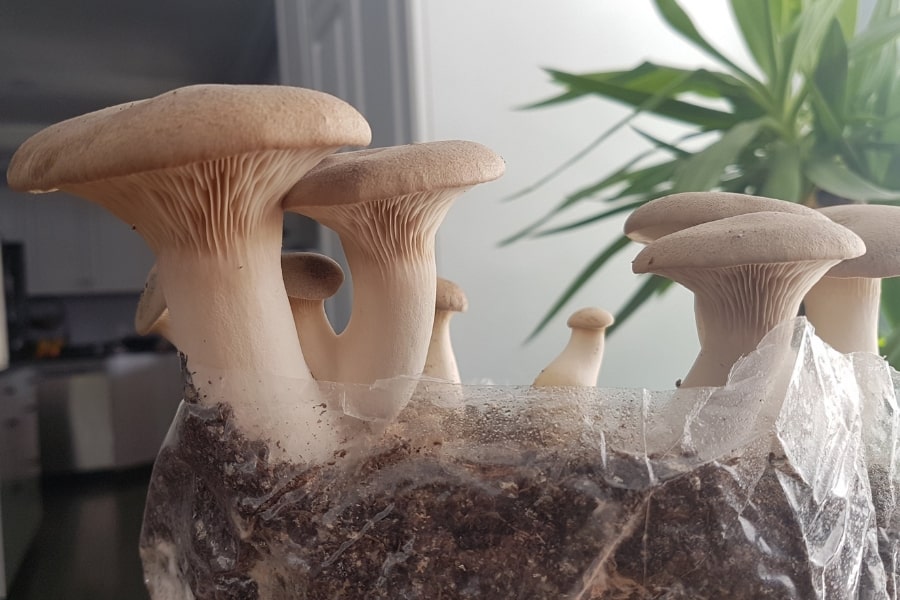
Common Names: King Oyster, King Trumpets
Type: Gourmet
King Oysters don’t look like your typical Oyster mushroom.
Instead of growing in large folded clusters with flat caps, King Oysters usually grow singly, and can form thick fat stems.
They are commonly cultivated in low CO2, low light environments, which give them tiny caps and huge stems. When grown outside, they form large brown caps and narrow stems.
Unlike most other oysters, Kings have an awesome shelf life- and can often remain in good condition up to 2 weeks after refrigeration. This durability makes them a good candidate to ship overseas, which is why you’ll often see Korean-grown King Oysters in US supermarkets.
This mushroom is very versatile, and can be used in soups, stews, and stir-frys. It can even be made into jerky!
19. Pleurotus nebrodensis
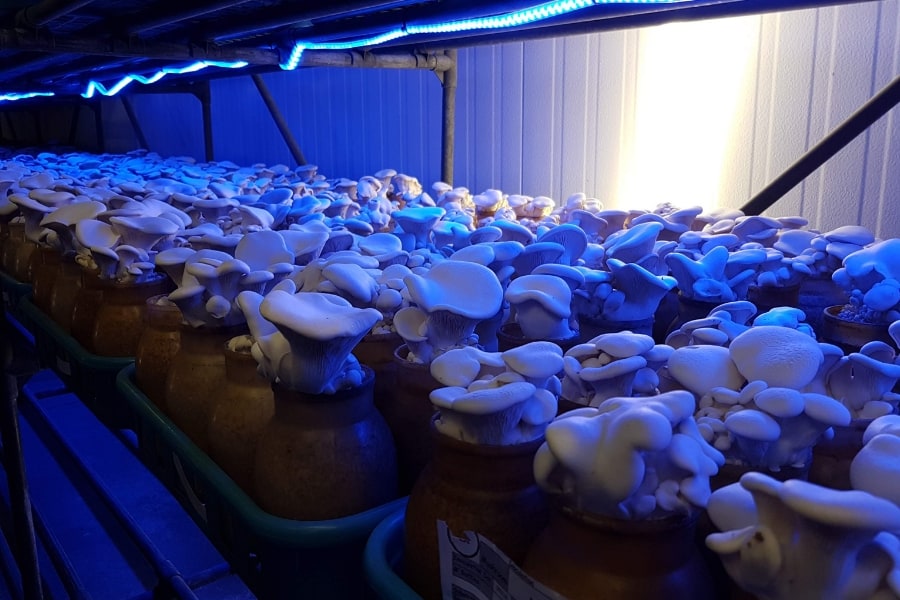
Common Names: White Elf Cap, Nebrodini Bianca
Type: Gourmet
This species is very similar to the King Oyster, and can be grown and cooked in much the same way. Still, cultivation of this mushroom is not common, with very few growers producing this species commercially.
The fruit body and caps are beige-white and quite large. They are substantial mushrooms, with a thick and meaty texture.
They can even be cooked on the BBQ!
Fun fact: Pleurotus nebrodensis has been listed as a critically endangered species since 2006. It grows naturally only in a very small region of Northern Italy.
20. Pleurotus ostreatus
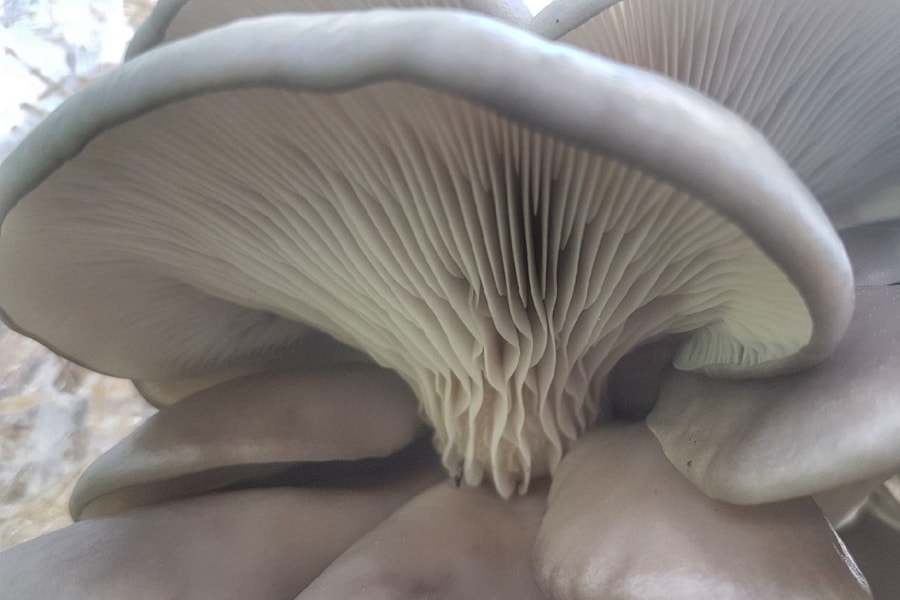
Common Names: Oyster
Type: Gourmet
This is your typical Oyster Mushroom.
It grows naturally all over the world on trees, stumps and fallen logs. It is also widely cultivated, and is one of the most commonly grown mushrooms in the world.
Oysters can grow on a bewildering number of substrates, including straw, hardwood, banana leaves, coffee, paper and cardboard, and pretty much any other plant based material.
They can even thrive in contaminated environments, and have lots of potential in the science of “myco-remediation”. Many new growers start off with this mushroom because of the ease of cultivation.
21. Pleurotus cintrinopileatus
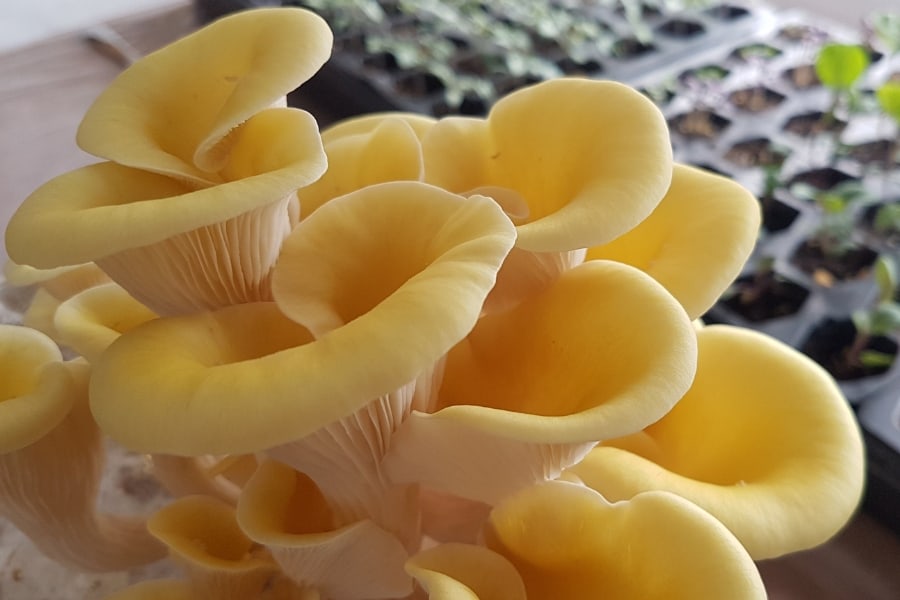
Common Names: Yellow Oyster, Golden Oyster
Type: Gourmet
This mushroom produces beautiful delicate “bouquets” of bright yellow mushrooms. They are similar to Pink Oysters in that they can turn a lot of heads at the farmer’s market!
They are easy to grow, and can be cultivated on both straw and hardwood sawdust. They are widely cultivated all over the world in both bags and bottles.
Yellow Oysters are slightly bitter in taste, although it the flavor can be greatly improved with proper cooking.
They also have a short shelf life, making them a poor candidate for packing up and sending to the grocery store.
Yellow Oysters are also known for being a good source of antioxidants, and have also been studied as a source to help with high cholesterol.
22. Stropharia rugosoannulata
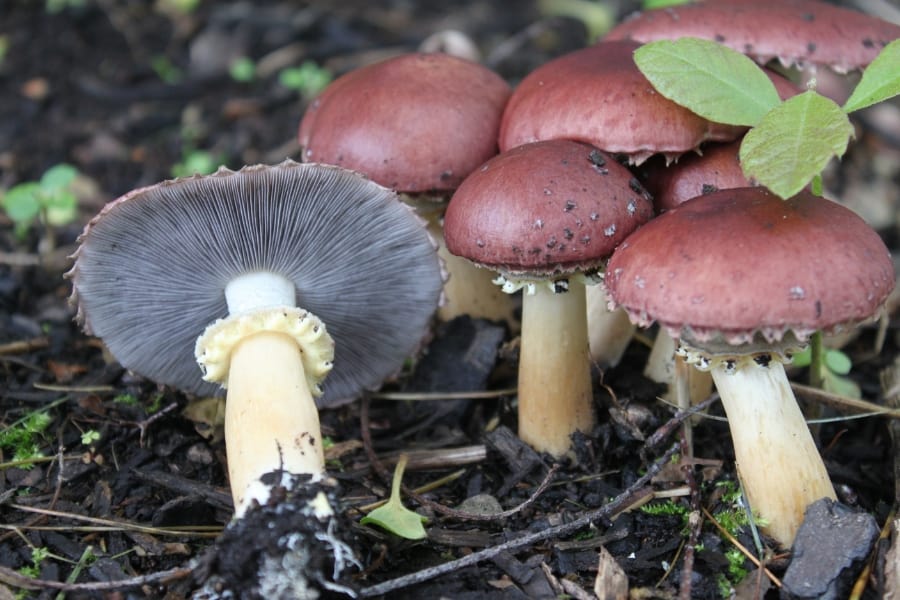
This image created by user Ann B. (Ann F. Berger) at Mushroom Observer, a source for mycological images, CC BY-SA 3.0, https://commons.wikimedia.org/w/index.php?curid=17426069
Common Name: The Wine cap, King Strapharia
Type: Gourmet
King Stropharia is one of the easiest mushrooms to grow at home.
By simply spreading myceliated sawdust into a pile of wood chips and leaving to sit over the summer, there is a good chance one will get a fruiting in the fall.
Because of this, Wine Caps are commonly cultivated in backyards all over the world. They are a wonderful gourmet species, suitable for many dishes.
They can also be grown commercially indoors, although not well enough to be viable for commercial production.
23. Trametes versicolor
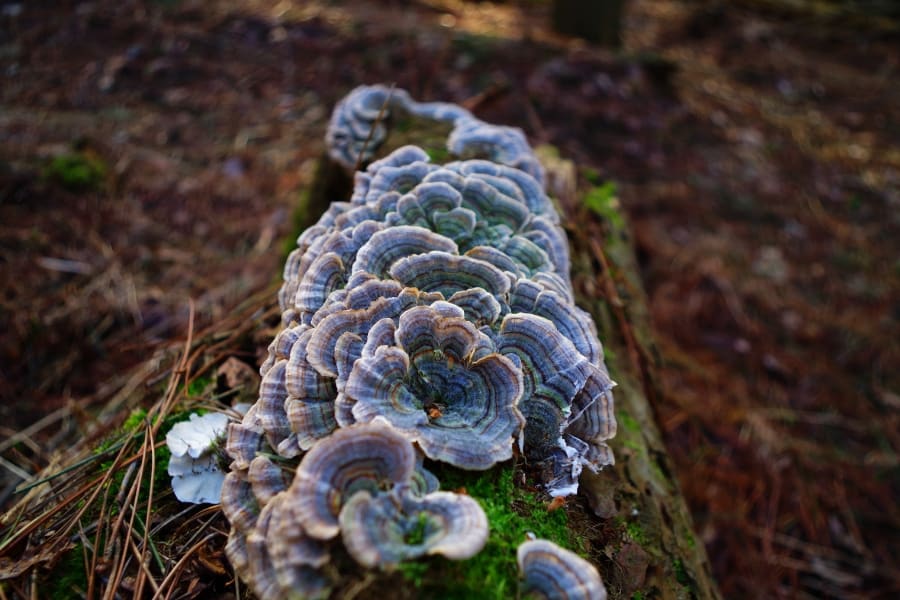
Common Name: Turkey Tail, Cloud Mushroom
Type: Medicinal
Turkey Tail is one of the most commonly found mushroom in the forest. It grows on fallen trees and stumps all over the world. If you spent any time walking down a forest path, there’s a good chance you’ve seen Turkey Tail.
But its amazing medicinal benefits are anything but common!
Turkey Tail is extremely high in beneficial beta-d-glucans, polysaccharides that act as “immuno-modulators”. Think of it like cruise control for the immune system.
Turkey Tail is easily cultivated on wood based substrates, although it often makes more economic sense for commercial operations to wild-harvest rather than cultivated this species.
24. Tremella fuciformis
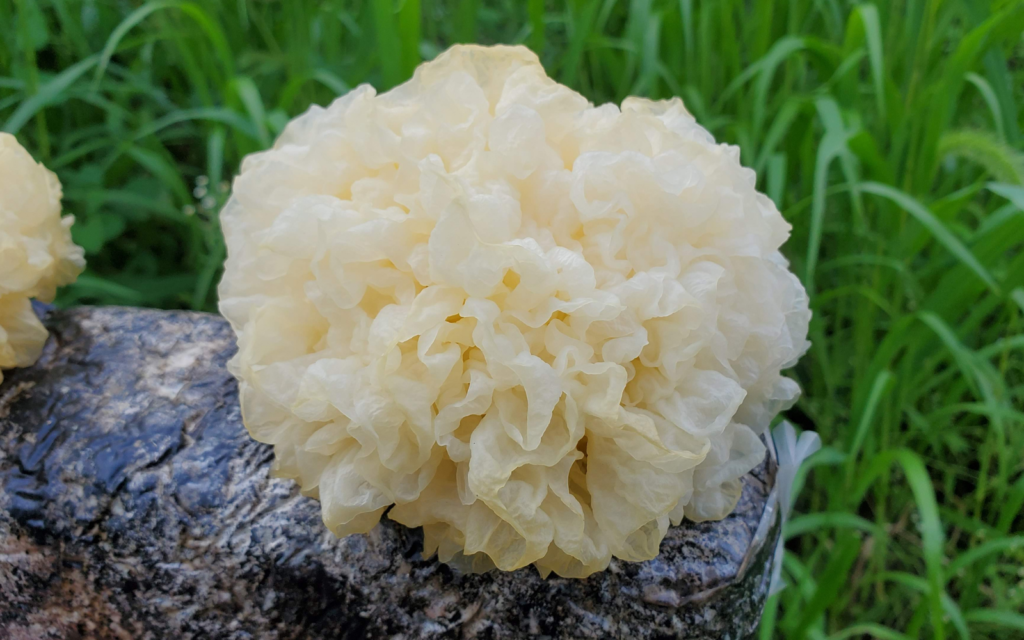
Common Name: Jelly Fungus, Tremella
Type: Gourmet, Medicinal
This mushroom is amazing to look at, and has a unique method of cultivation.
In order to produce fruits, Tremella needs to parasitize another host species. It starts off as just a slime mold, but once it encounters the other species of fungus, it starts aggressive mycelial growth and eventually is able to fruit.
Cultivators need to grow two species in conjunction- both the parasite and the host– in order to properly grow this mushroom commercially.
The fruit body forms in white, jelly-like folds.
Although it is essentially flavorless, it has a interesting texture and is super popular in Asian cooking. It is also used medicinally, and is thought to have anti-aging effects on the skin.
25. Volvariella volvacea
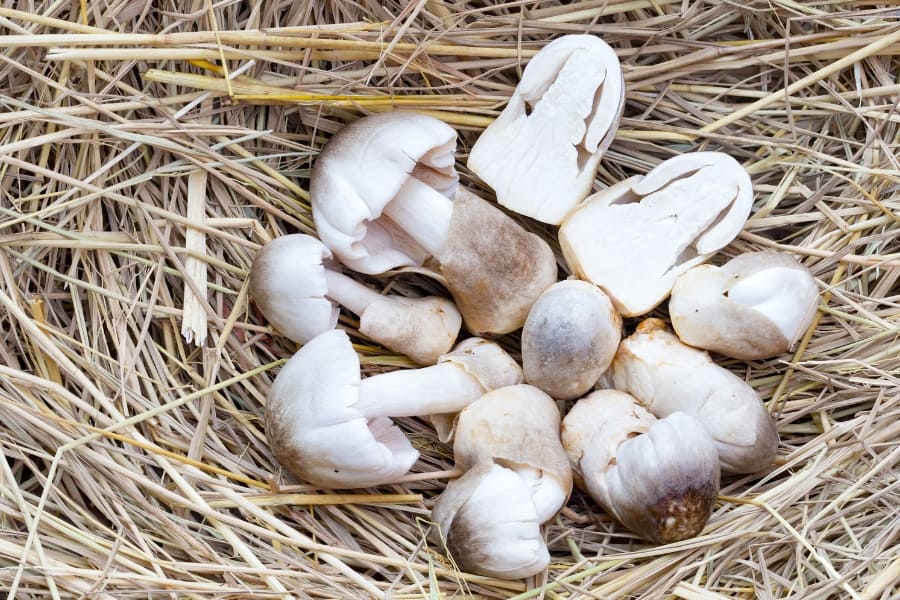
Common Name: Paddy Straw Mushroom
Type: Gourmet
Like the name implies, this mushroom grows on Paddy Straw, or Rice Staw, and is perfectly suitable for warmer climates.
It is commonly cultivated in outdoor mounds in India, and other Asian countries. It is a perfect candidate for “low-tech” cultivation methods.
Paddy straw mushrooms are available in both fresh and in canned form.
Not so-Fun Fact: Young Paddy straw mushroom fruit bodies look similar to the button form of Amanita phalloides- the Death Cap Mushroom. This misidentification is responsible for a number of deaths each year.
Phew…
So many types of mushrooms to choose from!
Of course, this isn’t a complete list- and I plan to eventually be adding more and more.
That being said, I hope this list has at least inspired you to try a new species- whether your growing, or just enjoying in a meal.



Wow! Thank you for putting together such a well-researched list of mushrooms you can cultivate. I’m going to try growing the Wine Cap and Oyster mushroom this year.
Glad you like it!! Thanks for checking it out- you’ve picked some good species to try 🙂
exellent compilation of usefull data on edible mushrooms.
I appreciate all the scientific names; it helped me discover material for a book I plan to write.
Great job on the page!
Thanks!! Glad you like it 🙂 I had fun putting it together. Good luck on the book-
Morninig from Spain Tony.
I´d like to know what range of temperatures are good for growing Flamulina Velutipes (Enoki) and Grifola frondosa (Maitake).
Aren´t you thinking about making an article for Enoki and Maitake???
Thank you very much for this amazing article.
QUESTION— Are the habitats for all of these mushrooms conducive to Appalachian highlands of North America? (With the exception of the strictly native Japanese mushroom of course). They seem to be, but I’m doubting myself on this— excellent information and well written article!
Let me know your opinion on this. Thx